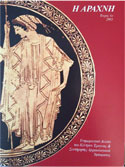Dyes
Dyes copy.jpg

Dyestuffs for textile dyeing.
Dyestuffs are counted among the raw materials required for textile production. Information on the nature and characteristics of these dyestuffs can be collected from written sources, such as Theophrastus and Aristotle, from discoveries of traces of colour in archaeological excavations and, of course, from extant textiles that preserve traces of colour.
Dyestuffs used in textile production derive from plants and animals. Besides of substances mentioned in ancient texts, ancient Greeks were able to use a large variety of everyday plants, many of which were still used in textile dyeing in the Greek countryside until recently. Plants such as onion, chamomile, grenade and many others were among the easy choices.
Dyestuffs from plants that are mentioned in written sources are the crocus (krokos, Crocus sativus) that produces ochre hues, madder (erythrodanon or ereuthedanon, Rubia tinctorum) producing a red colour, isatis (isatis, Isatis tinctoria) for blue dyes, the oak yielding shades of brown and black, orchil, a species of lichen (phykos, Rochella tinctoria) that produces a spectre of colours from rose to blue and alkanet or dyers’ bugloss (lakcha or anchousa, Alkanna or Anchusa tinctoria), a plant that produces a red dye, which in antiquity was used in medicine, make-up and as a substitute for shellfish dye.
Among these, the most well-known and older dye is crocus, saffron. It derives from the stigmas of the crocus flower. Mural paintings from Akrotiri, Thera, dated to the 17th century BC depict girls picking crocus stigmas probably to use in textile dyeing. Crocus colour was highly estimated in ancient Greece and many terms refer to garments dyed in this colour (the girls serving the sanctuary of Artemis at Brauron as bears wore saffron-coloured garments (krokōtos), while the famous peplos of Athena is also described as saffron-coloured).
Besides plants, dyestuffs also derive from animals, such as kermes (kokkos baphikē, Kermococcus vermilio) and seashell purple (porphyra).
Theophrastus describes kermes as a minuscule insect living in the kermes oak (Quercus coccifera). The kermes dye was one of the most beautiful and appreciated red dyes in Antiquity because of its brilliance and stability. From the term kokkos, describing the insect, derives the term kokkinos, red, in Modern Greek. Ancient written sources also mention a synonym for the ‘kermes oak’ and the red dye, hysgē, with the adjectives hysginos and hysginobaphēs for the products of the dye.
Seashell purple is the most famous dye not only of Antiquity, but also of the whole human history. It derives from the hypobranchial gland of several types of molluscs: Hexaplex trunculus, Bolinus brandaris, Stramonita haemastoma. It is a complicated dye and every mollusc requires a particular technique and know-how; this is why there are professional purple dyers (porphyrobaphoi, halourgōplai) mentioned in Classical Athens. The quantity of shells required for the production of a small quantity of dye was so great, the process so complicated and time-consuming, and the colours created so variegated, shiny and stable, that purple soon became the most expensive and luxurious ancient dye. In the 4th century BC, Demosthenes mentions that purple cost its weight in silver, while in the Byzantine period purple garments were intended exclusively for the imperial family.
The purple dyestuff cannot dye directly the fibres because it is insoluble in water and dyers had to find ways to render it soluble in order for the pigments to impregnate the textile fibres. Generally the ph of the bath is changed to alkaline with the addition of alkaline solutions and ammonia from old urine. The fibres absorb the dye in its soluble form, barely coloured in a greenish-yellow. As they are taken out of the vat and exposed to oxygen in the air, purple precipitates inside the fibres and at the textile’s surface. The shades thus produced are stable and depend on the time of exposure in the air. The more time the fibres or fabrics stay exposed to oxygen in the air, the darker will be the hue of the colour. Through successive dye-baths and using either the dyestuff of a single mollusc or a mixture, dyers were able to produce a wide range of shades between pink and blue.
Seashell purple has been identified in Proto Geometric period fabrics from Stamna, Aitolia (11th-10th c. BC), as well as in Archaic period fabrics from Corfu (7th c. BC), Classical period textiles from Kalyvia, Kerameikos and Maroussi in Attica (5th c. BC) and Roman textiles from the Kerameikos (3th c. BC) and Thessaloniki (4th c. BC).
Indicative Bibliography:
Barber, E. J. W. 1991 Prehistoric Textiles: the development of cloth in the Neolithic and Bronze Age with special reference to the Aegean. Princeton University Press.
Cardon, D. 2003 Le monde des teintures naturelles, Paris, Éditions Belin.
Kardara, Chr. 1961 Dyeing and Weaving Works at Isthmia, American Journal of Archaeology, 65, no. 3, 261-266.


